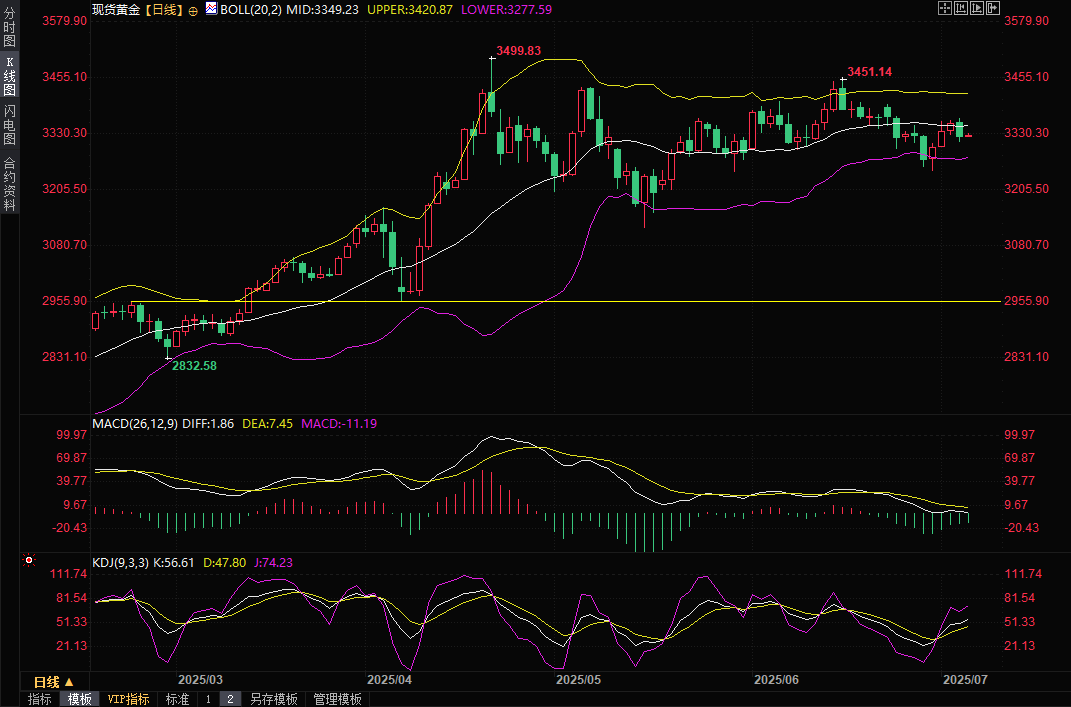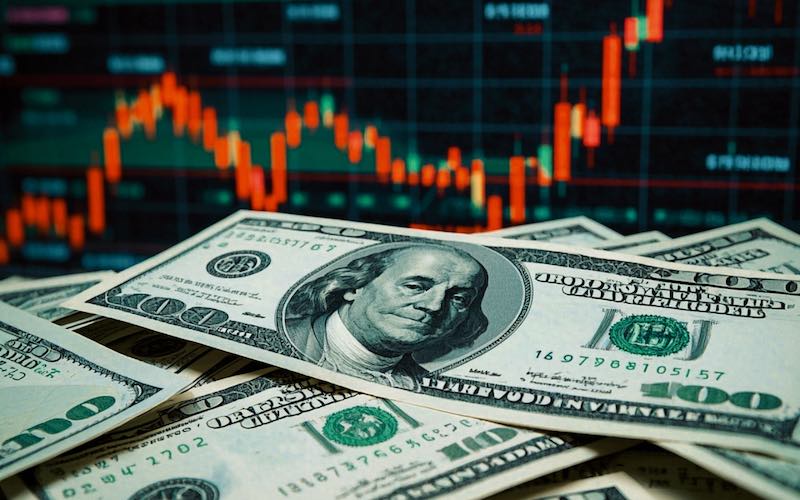Gold trading reminder: Non-farm data suppressed expectations of interest rate cuts, gold prices fell nearly 1%, and the "big and beautiful" bill may exacerbate volatility?
2025-07-04 07:44:35

Strong employment data dampens expectations of a Fed rate cut
The latest non-farm employment report for June released by the U.S. Bureau of Labor Statistics showed that the United States added 147,000 jobs, far exceeding market expectations of 110,000, showing strong momentum in the labor market.
Although the unemployment rate fell slightly from 4.2% to 4.1%, there are some concerns behind this impressive data. The report pointed out that nearly half of the job growth came from the government sector, while the increase in private sector jobs was only 74,000, the smallest increase since October 2024. In addition, the average weekly working hours shortened from 34.3 hours to 34.2 hours, and wage growth slowed down. The average hourly wage rose by only 0.2% month-on-month, and the year-on-year increase fell from 3.8% to 3.7%.
The details suggest that despite strong overall employment data, weakness in the private sector and a potential slowdown in the labor market could sow uncertainty about future economic trends.
Dollar and U.S. Treasury yields rise
The strong employment data directly pushed up the dollar and U.S. Treasury yields. The dollar index rose 0.34% to 97.12 on Thursday, while the two-year Treasury yield climbed 9.7 basis points to 3.789%, and the ten-year Treasury yield also rose to 4.346%. The stronger dollar makes gold less attractive to overseas buyers because gold denominated in dollars becomes more expensive.
David Meger, director of metals trading at High Ridge Futures, pointed out: "Better-than-expected employment means that the possibility of the Federal Reserve cutting interest rates early has been greatly reduced, and the strengthening of the US dollar has put significant pressure on the gold market."
The market's expectations for the Fed's July rate cut have almost dropped to zero, and the probability of a 25 basis point rate cut in September has also dropped from 92.5% to 67%. This shift has directly led to a decline in gold prices, and investors' safe-haven demand for gold has been temporarily suppressed.
Re-examining the Fed’s monetary policy path
The Fed's monetary policy has always been a core factor affecting gold prices. As an interest-free asset, gold is usually more attractive in a low-interest environment, while high interest rates will weaken its investment value. The Fed's benchmark interest rate is currently maintained in the range of 4.25% to 4.5%, and the market originally expected that the Fed might cut interest rates in advance due to the economic slowdown. However, the strong performance of the non-agricultural data in June and the potential inflationary pressure of the Trump administration's new policy have increased the possibility that the Fed will continue to wait and see.
Investors currently expect the Fed to cut interest rates by 51 basis points by the end of the year, starting in October, down from expectations of about 66 basis points before the report was released.
In an interview, U.S. Treasury Secretary Benson said that if the Fed does not cut interest rates in the near future, a larger rate cut may be needed in September to cope with economic changes. Although this statement has injected some easing expectations into the market, the Fed's cautious attitude is undoubtedly bearish for gold in the short term.
In addition, the news that the Trump administration plans to look for a successor to Federal Reserve Chairman Powell in the fall has further exacerbated monetary policy uncertainty. Since Powell became the chairman of the Federal Reserve in 2018, he has responded to multiple economic challenges with a prudent monetary policy, but Trump has never stopped criticizing his policies. The nomination of a new chairman may bring about a change in policy style, and market expectations of this will also affect the short-term volatility of gold.
Eugenio Aleman, chief economist at Raymond James, said: "Despite overall strong employment data, weakness in the private sector could reignite discussions about the Fed's interest rate path." Against the backdrop of inflationary pressure and a slowing labor market, the pace and magnitude of the Fed's future interest rate cuts will become an important observation point for the gold market.
Uncertainty over Trump's policies fuels market volatility
The massive tax cut and spending bill passed by the Trump administration on Thursday has brought new uncertainty to the gold market. The bill is expected to increase U.S. debt by $3.4 trillion over the next decade, while stimulating economic growth by making the 2017 tax cuts permanent, expanding tax breaks, and cutting spending on health care and green energy projects. Republicans believe this will inject "jet fuel" into the economy and boost private sector investment and consumption. However, nonpartisan analysts warn that new debt and large tax cuts could exacerbate inflationary pressures, especially as the job market remains strong. Rising inflation expectations are usually good for gold, but the current trend of a stronger dollar and rising U.S. Treasury yields has temporarily overshadowed this positive news.
In addition, Trump's anti-growth policies, such as comprehensive tariffs on imported goods and large-scale deportations of immigrants, may have a profound impact on the labor market and economic momentum. The June non-farm report showed that 130,000 people withdrew from the labor market, the number of long-term unemployed people increased to 1.647 million, and the median duration of unemployment increased from 9.5 weeks to 10.1 weeks. These signs indicate that the labor market may face further pressure due to policy changes.
Companies' cautious attitude towards hiring is also reflected in the survey of the Institute for Supply Management (ISM), with some companies explicitly stating that they will prioritize using existing employees rather than adding new employees. The Trump administration claims that tariffs will not push up inflation in the long run, but the market remains skeptical about this, and the appeal of gold as an anti-inflation asset may reappear in the future.
Huanghou City Outlook
Looking ahead, the gold market will be driven by multiple factors. First, the Fed's monetary policy path remains key. If the rate cuts pick up in September, gold may see a rebound. Second, the Trump administration's fiscal and trade policies will continue to affect market sentiment. Tax cuts and tariffs may push up inflation expectations in the short term, thereby providing support for gold, but the strength of the US dollar and rising US bond yields may continue to put pressure on gold prices. In addition, global geopolitical and economic uncertainties remain long-term positive factors for gold. Although the current market expectations for the Fed to cut interest rates in advance have weakened, signs of a global economic slowdown may prompt investors to reallocate funds to safe-haven assets.
From a technical perspective, gold prices fluctuated in a narrow range around $3,330 and may continue to be under pressure from a stronger dollar and rising U.S. bond yields in the short term. However, if gold prices fall below the $3,300 support level, they may further test the key level of $3,250; conversely, if inflation expectations rise or geopolitical risks intensify, gold prices are expected to return to above $3,400. Investors should pay close attention to the Fed's interest rate decisions, the Trump administration's policy implementation, and global macroeconomic data to seize investment opportunities in the gold market.

(Spot gold daily chart, source: Yihuitong)
At 07:40 Beijing time, spot gold was trading at $3,330.75 per ounce.
- Risk Warning and Disclaimer
- The market involves risk, and trading may not be suitable for all investors. This article is for reference only and does not constitute personal investment advice, nor does it take into account certain users’ specific investment objectives, financial situation, or other needs. Any investment decisions made based on this information are at your own risk.










